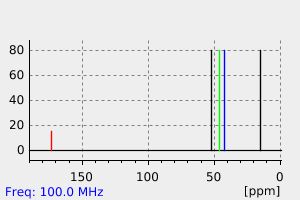3-氯-2-甲基丙酸甲酯 | 10317-11-0
中文名称
3-氯-2-甲基丙酸甲酯
中文别名
——
英文名称
methyl 3-chloro-2-methylpropanoate
英文别名
methyl 3-chloro-2-methylpropionate;3-chloro-2-methyl-propionic acid methyl ester;β-chloro-isobutyric acid methyl ester;β-Chlor-isobuttersaeure-methylester;3-Chlor-2-methyl-propionsaeure-methylester;2-Chlor-1-methylpropionsaeuremethylester
CAS
10317-11-0
化学式
C5H9ClO2
mdl
——
分子量
136.578
InChiKey
CHTWJLYZRAJEKG-UHFFFAOYSA-N
BEILSTEIN
——
EINECS
——
-
物化性质
-
计算性质
-
ADMET
-
安全信息
-
SDS
-
制备方法与用途
-
上下游信息
-
文献信息
-
表征谱图
-
同类化合物
-
相关功能分类
-
相关结构分类
计算性质
-
辛醇/水分配系数(LogP):1.2
-
重原子数:8
-
可旋转键数:3
-
环数:0.0
-
sp3杂化的碳原子比例:0.8
-
拓扑面积:26.3
-
氢给体数:0
-
氢受体数:2
上下游信息
-
上游原料
中文名称 英文名称 CAS号 化学式 分子量 3-氯-2-甲基丙酸 3-chloroisobutyric acid 16674-04-7 C4H7ClO2 122.551 异丁酸甲酯 Methyl isobutyrate 547-63-7 C5H10O2 102.133
反应信息
-
作为反应物:描述:参考文献:名称:Copper-catalyzed acylation and conjugate addition of zinc homoenolate. Synthesis of 4- and 5-oxo esters摘要:DOI:10.1021/ja00323a060
-
作为产物:描述:参考文献:名称:The Chloro- and Bromoisobutyronitriles摘要:DOI:10.1021/ja01181a048
文献信息
-
Fused ring compound and use thereof申请人:Suzuki Hideo公开号:US20100190747A1公开(公告)日:2010-07-29The present invention provides a compound represented by the formula: wherein the symbols are as described in the specification, or a salt thereof, which is useful for preventing/treating eicosanoid-associated diseases such as atherosclerosis, diabetes, obesity, atherothrombosis, asthma, fever, pain, cancer, rheumatism, osteoarthritis and atopic dermatitis, and which has an excellent pharmacological action, physicochemical properties, etc.
-
Phosphonic acid derivatives as inhibitors of protein tyrosine phosphatase IB (PTP-IB)申请人:——公开号:US20020052344A1公开(公告)日:2002-05-02The invention encompasses the novel class of compounds represented by formula I which are inhibitors of the PTP-1B enzyme. 1 The invention also encompasses pharmaceutical compositions and methods of treating or preventing PTP-1B mediated diseases, including diabetes, obesity, and diabetes-related diseases.
-
Trichlorotitanium and alkoxytitanium homoenolates. Preparation, characterization, and utilization for organic synthesis作者:Eiichi. Nakamura、Hiroji. Oshino、Isao. KuwajimaDOI:10.1021/ja00273a032日期:1986.6demi-equivalent d'alcoolate de titane (IV) sont plus reactives que I, fournissant des voies d'acces a des hydroxy-4 esters, γ-lactones et cyclopropanecarboxylates. Discussion du mecanisme de formation des homoenolates
-
Study of microplasticity in 304L stainless steel作者:P. Vaucheret、A. GaltierDOI:10.1051/metal:2002181日期:2002.1Discontinuities of microstructure in steels induce stress concentrations. Microplasticity is the plasticity which exists locally at these stress concentrations, whereas the remainder of the material is in the elastic domain. The microplasticity threshold is the nominal stress in uniaxial loading from which microplasticity exists. During fatigue tests, this threshold has been determined for the 304 L stainless steel by measurements of temperature variations, informations derived from hysteresis loops, observations of microstructure at the surface of polished specimens. The microplasticity threshold of the studied material is between 60 and 75 MPa.钢材微观结构的不连续性会导致应力集中。微塑性是存在于这些应力集中处的局部塑性,而材料的其余部分则处于弹性区域。微塑性阈值是存在微塑性的单轴加载额定应力。在疲劳试验过程中,304 L 不锈钢的微塑性阈值是通过测量温度变化、滞后环得出的信息以及观察抛光试样表面的微观结构确定的。所研究材料的微塑性临界值在 60 至 75 兆帕之间。
-
A1H NMR and molecular modelling investigation of diastereotopic methylene hydrogen atoms作者:Cl�udio F. Tormena、Matheus P. Freitas、Roberto Rittner、Raymond J. AbrahamDOI:10.1002/mrc.1011日期:2002.4The 1H NMR spectra of methyl 3-bromo-2-methylpropionate (1a) and the corresponding chloro compound (2a) show no long-range coupling between the methyl and methylene protons. In contrast, in the analogous dihalocompounds, methyl 2,3-dibromo-2-methylpropionate (1b) and methyl 2,3-dichloro-2-methylpropionate (2b), one of the methylene protons exhibits a large 4JHH coupling (0.8 Hz) to the methyl group, but the other proton shows no observable splitting. This can be explained quantitatively by calculations of the conformational preferences in these compounds combined with the known orientation dependence of the 4JHHcouplings. One conformer predominates in the dihalo compounds 1b and 2b, and this is responsible for the 4JHH coupling. In 1a and 2a all three conformers are populated and the 4JHH couplings average to zero. The technique is a potentially general method of unambiguously assigning diastereotopic methylene protons. Copyright © 2002 John Wiley & Sons, Ltd.3-溴-2-甲基丙酸甲酯 (1a) 和相应的氯化合物 (2a) 的 1 H NMR 谱显示甲基和亚甲基质子之间没有长程耦合。相比之下,在类似的二卤代化合物 2,3-二溴-2-甲基丙酸甲酯 (1b) 和 2,3-二氯-2-甲基丙酸甲酯 (2b) 中,其中一个亚甲基质子表现出较大的 4JHH 耦合 (0.8 Hz)到甲基,但另一个质子没有显示出可观察到的分裂。这可以通过计算这些化合物的构象偏好并结合已知的 4JHH 偶联方向依赖性来定量解释。在二卤代化合物 1b 和 2b 中,一种构象异构体占主导地位,这就是 4JHH 偶联的原因。在 1a 和 2a 中,所有三个构象异构体均已填充,并且 4JHH 耦合平均值为零。该技术是明确分配非对映亚甲基质子的潜在通用方法。版权所有 © 2002 约翰威利父子有限公司
表征谱图
-
氢谱1HNMR
-
质谱MS
-
碳谱13CNMR
-
红外IR
-
拉曼Raman
-
峰位数据
-
峰位匹配
-
表征信息
同类化合物
(甲基3-(二甲基氨基)-2-苯基-2H-azirene-2-羧酸乙酯)
(±)-盐酸氯吡格雷
(±)-丙酰肉碱氯化物
(d(CH2)51,Tyr(Me)2,Arg8)-血管加压素
(S)-(+)-α-氨基-4-羧基-2-甲基苯乙酸
(S)-阿拉考特盐酸盐
(S)-赖诺普利-d5钠
(S)-2-氨基-5-氧代己酸,氢溴酸盐
(S)-2-[[[(1R,2R)-2-[[[3,5-双(叔丁基)-2-羟基苯基]亚甲基]氨基]环己基]硫脲基]-N-苄基-N,3,3-三甲基丁酰胺
(S)-2-[3-[(1R,2R)-2-(二丙基氨基)环己基]硫脲基]-N-异丙基-3,3-二甲基丁酰胺
(S)-1-(4-氨基氧基乙酰胺基苄基)乙二胺四乙酸
(S)-1-[N-[3-苯基-1-[(苯基甲氧基)羰基]丙基]-L-丙氨酰基]-L-脯氨酸
(R)-乙基N-甲酰基-N-(1-苯乙基)甘氨酸
(R)-丙酰肉碱-d3氯化物
(R)-4-N-Cbz-哌嗪-2-甲酸甲酯
(R)-3-氨基-2-苄基丙酸盐酸盐
(R)-1-(3-溴-2-甲基-1-氧丙基)-L-脯氨酸
(N-[(苄氧基)羰基]丙氨酰-N〜5〜-(diaminomethylidene)鸟氨酸)
(6-氯-2-吲哚基甲基)乙酰氨基丙二酸二乙酯
(4R)-N-亚硝基噻唑烷-4-羧酸
(3R)-1-噻-4-氮杂螺[4.4]壬烷-3-羧酸
(3-硝基-1H-1,2,4-三唑-1-基)乙酸乙酯
(2S,4R)-Boc-4-环己基-吡咯烷-2-羧酸
(2S,3S,5S)-2-氨基-3-羟基-1,6-二苯己烷-5-N-氨基甲酰基-L-缬氨酸
(2S,3S)-3-((S)-1-((1-(4-氟苯基)-1H-1,2,3-三唑-4-基)-甲基氨基)-1-氧-3-(噻唑-4-基)丙-2-基氨基甲酰基)-环氧乙烷-2-羧酸
(2S)-2,6-二氨基-N-[4-(5-氟-1,3-苯并噻唑-2-基)-2-甲基苯基]己酰胺二盐酸盐
(2S)-2-氨基-N,3,3-三甲基-N-(苯甲基)丁酰胺
(2S)-2-氨基-3-甲基-N-2-吡啶基丁酰胺
(2S)-2-氨基-3,3-二甲基-N-(苯基甲基)丁酰胺,
(2S)-2-氨基-3,3-二甲基-N-2-吡啶基丁酰胺
(2S,4R)-1-((S)-2-氨基-3,3-二甲基丁酰基)-4-羟基-N-(4-(4-甲基噻唑-5-基)苄基)吡咯烷-2-甲酰胺盐酸盐
(2R,3'S)苯那普利叔丁基酯d5
(2R)-2-氨基-3,3-二甲基-N-(苯甲基)丁酰胺
(2-氯丙烯基)草酰氯
(1S,3S,5S)-2-Boc-2-氮杂双环[3.1.0]己烷-3-羧酸
(1R,5R,6R)-5-(1-乙基丙氧基)-7-氧杂双环[4.1.0]庚-3-烯-3-羧酸乙基酯
(1R,4R,5S,6R)-4-氨基-2-氧杂双环[3.1.0]己烷-4,6-二羧酸
齐特巴坦
齐德巴坦钠盐
齐墩果-12-烯-28-酸,2,3-二羟基-,苯基甲基酯,(2a,3a)-
齐墩果-12-烯-28-酸,2,3-二羟基-,羧基甲基酯,(2a,3b)-(9CI)
黄酮-8-乙酸二甲氨基乙基酯
黄荧菌素
黄体生成激素释放激素(1-6)
黄体生成激素释放激素 (1-5) 酰肼
黄体瑞林
麦醇溶蛋白
麦角硫因
麦芽聚糖六乙酸酯
麦根酸







